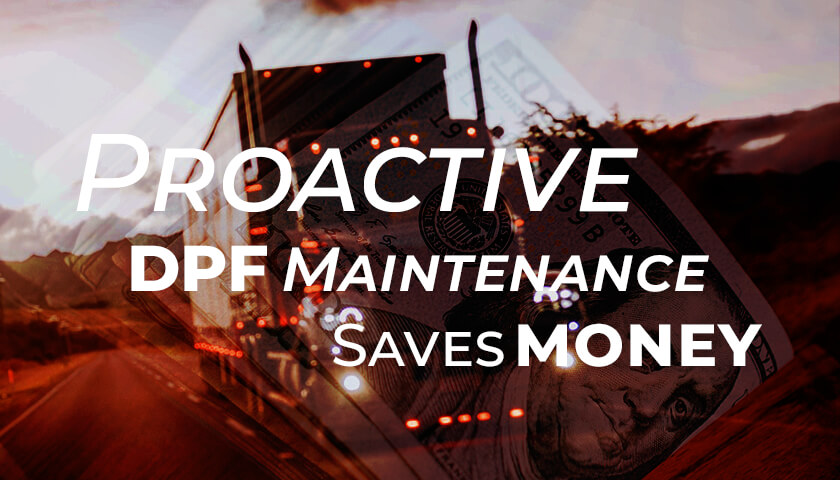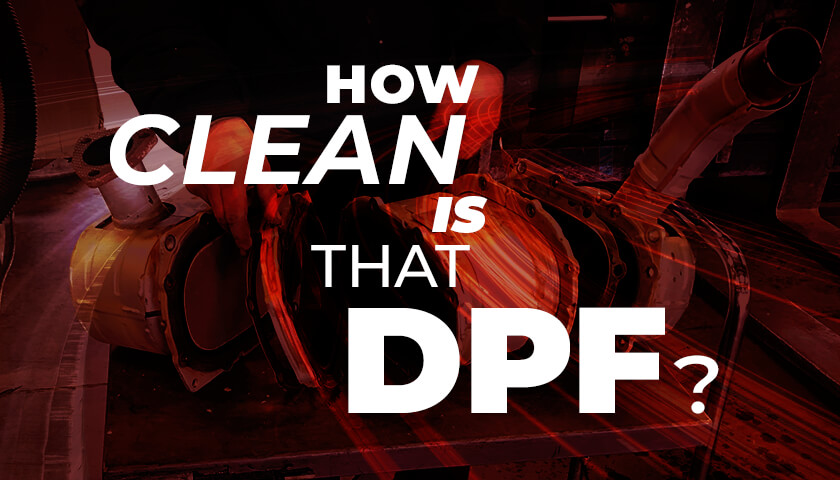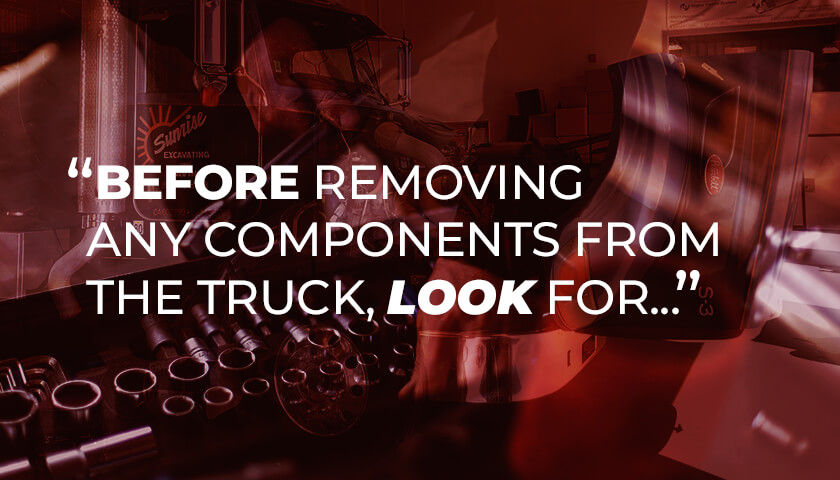Proactive DPF Maintenance Saves Money
When the aftertreatment system was introduced in 2007, manufacturers assured truck owners and fleet managers that they would be virtually maintenance-free. In the nearly 15 years since we’ve learned that isn’t the case. Vital components of your aftertreatment system need regular, proactive maintenance in order to avoid expensive repairs and unexpected downtime. If you’ve been putting off DPF maintenance, let’s look at how proactively maintaining your DPF and other aftertreatment parts can save you time, money, and stress.

OEM Recommendations vs DPF Cleaning Shop Recommendations
Original DPF manufacturers suggest a service interval of about 200,000 miles or roughly 6,000 hours of service. However, vehicles that follow this timeline often find the DPF indicator light coming on much sooner, resulting in unplanned downtime for cleaning.
On the other hand, DPF cleaning shops recommend a much shorter interval: at least once per year or every 1,000 hours of service. Depending on the vehicle’s duty cycle, that interval might be as short as every 6 months. Factors like city driving and lots of idling create more soot and ash. If you have a mixed fleet, say on-highway and city delivery vehicles, your cleaning cycles can be very different for each category.
Reasons Why Recommendations Differ
Why the discrepancy? It’s true, a DPF might last 200,000 miles before getting clogged and sending the engine into limp mode. However, when that DPF is cleaned, there will be a large amount of hardened ash, which might not be able to be completely removed. By the second or third cleaning interval, the DPF could be irreparably damaged. DPF cleaning shops know this well. They recommend a shorter DPF service interval to keep your DPF clean and good as new for as long as possible. Remember, the DPF was designed to be a serviceable filter.

Advantages of Proactive Maintenance
There are many advantages of a proactive DPF maintenance plan. First, by scheduling maintenance instead of waiting for a failure, you can plan for downtime. Waiting to see the DPF indicator light on the dashboard means that the dirty DPF is already affecting the rest of the engine upstream, and possibly more aftertreatment components downstream. It also could send the engine into limp mode, meaning missed deliveries, unexpected downtime, and unhappy customers. Instead, planning an annual DPF cleaning service means you can work around deliveries, and add DPF cleaning to other routine maintenance.
Second, cleaning your DPF more often allowed for less hardened ash buildup. This means that your DPF will last longer before needing replacement. A new DPF can cost upwards of $4,500, so regular cleaning can save you an expensive and unexpected replacement.
Finally, the cleaner your DPF is, the better your fuel economy and engine performance will be. When the DPF is clogged, it creates back pressure upstream to the engine. This increases the amount of fuel consumed and can even cause other engine components to fail. A healthy, clean DPF allows exhaust to flow through it freely, catching the particulate matter and keeping your engine compliant with emissions standards.

How to Ensure Your DPF Is Clean: Pin Test and Tap Test
Since the DPF is a closed unit, it’s hard to tell if it’s clean just by looking at it. After your DPF has been serviced and you receive it back from the shop, there are two easy ways to tell if it’s been thoroughly cleaned:
Tap Test:
Place your DPF on the floor, INLET side down. Gently raise and lower the filter, tapping it against the floor. If any debris or more than a light dusting of beige ash comes out, your DPF was not cleaned properly. If you see black “ash” or rods that look like pencil lead, your DPF was not thoroughly cleaned.
Pin Test:
Begin by inserting a “pin” into the outlet side of the DPF. Check several cells to get a feel for a clean cell and an idea of the depth of the filter channel. Then insert the pin gauge into several cells on the inlet side of your DPF. Use a star pattern across the face. The cells should all be the same depth as the outlet side. If they aren’t, it doesn’t necessarily mean the shop is to blame. Some DPFs will have sintering or ash which has over time become cement-like and almost impossible to remove. Over time sintering can reduce the flow efficiency of a DPF. It may be time for a new filter.
Importance of Documentation
Documentation is critical to the ongoing health of your DPF and the aftertreatment system. The DPF cleaning shop you choose should record the before-cleaning and after-cleaning weight and flow of your filter, to see how much ash and soot were removed. In a clean filter, you should see a reduction of weight and an increase in flow. If you see one but not the other, this could be a sign the filter was not thoroughly cleaned, or that there is another problem with your filter.
The after-cleaning weight should also be compared to the weight of the filter when it was brand new. DPFs from Redline Emissions Products® feature the patent-pending Born-on-Weight™, which shows the weight of your filter when new from the factory, printed right on the label.

What to Look for When Dropping a DPF
Before removing any components from the truck, look for signs of exhaust leaks. These leaks can lead to problems with emission system performance. Be sure to repair any leaks upstream of the system.
When removing a unit from a truck, look for signs of oil, fuel, or coolant. This can be an early warning of upcoming maintenance issues. Now can be a good time to run the engine looking for signs of smoke. In the days prior to emission systems, white, blue, or excessive black smoke were signs of engine problems.
Also, take note if there is any face plugging present. There are some possible reasons why this may occur, like excessive idling. Another possibility is over-fueling caused by upstream issues, such as a plugged air intake filter or leaks in the CAC system.
Why Replace Clamps and Gaskets
Your DPF can get up to 1,200 degrees Fahrenheit during a regeneration cycle, and so do the clamps and gaskets that hold it in place. While they are designed for these extreme temperature fluctuations, the constant heating and cooling, road vibration, and other factors can weaken the metal they are made from. Over time, clamps can loosen, and gaskets can warp out of shape.
Reinstalling a cleaned DPF with used clamps or gaskets can lead to exhaust leaks. It’s considered best practice to use new clamps and gaskets when reinstalling the filter.
This small extra cost can save hours of unplanned downtime and repairs in the future.
When to Replace Sensors
Sensors are your engine’s feedback loop, letting you know if the emissions system is doing its job. Sensors are, by their nature, sensitive! But they’re subject to the same stresses as the rest of the engine and aftertreatment system. High temperatures, temperature fluctuations, bumps and potholes, and constant vibration all put your sensors at risk. The biggest risk is that a sensor will fail, causing unexpected downtime. It’s best practice to replace sensors at a regular interval before they fail.
Also, sensors can often be difficult to remove from a filter. If your tech is wrestling to remove a sensor, this might be a good time to replace it. While the original may function when re-installed, it may not work for long and may lead to downtime or a tow bill. So, while you have your vehicle in the shop for a DPF cleaning, consider getting your sensors replaced as well.
Become a REP Dealer
If you sell heavy-duty parts and want to get into the business of selling aftertreatment replacement parts and cleaning equipment, contact us today to discuss becoming one of our parts distributors.
Reach out to Wayne Cochrane, National Sales Manager for REP to find out more or call 888-295-4670.








